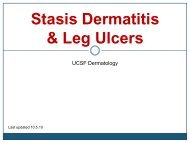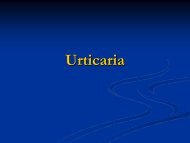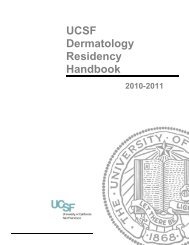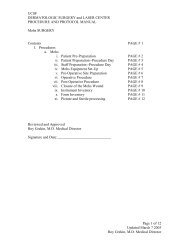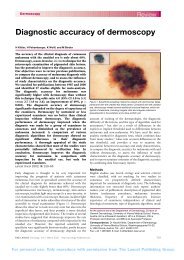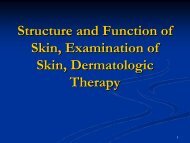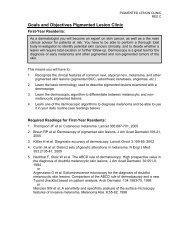Itchy Red Rash - Dermatology
Itchy Red Rash - Dermatology
Itchy Red Rash - Dermatology
Create successful ePaper yourself
Turn your PDF publications into a flip-book with our unique Google optimized e-Paper software.
<strong>Itchy</strong> <strong>Red</strong> <strong>Rash</strong>
Module Instructions<br />
The following module contains hyperlinked<br />
information which serves to offer more<br />
information on topics you may or may not be<br />
familiar with. We encourage that you read all the<br />
hyperlinked information.
Case 1
Case 1: History<br />
CC: “She She scratches all night” night<br />
HPI:<br />
10 month-old month old girl presents with a 7 month<br />
history of an itchy itchy red red rash rash involving her face<br />
and body, which waxes and wanes.<br />
Her parents report that they bathe her daily and<br />
use Ivory soap. Sometimes they use Lubriderm<br />
lotion if her skin appears dry. They recently<br />
introduced peas into her diet and wonder<br />
whether this may be contributing to the rash.
Case 1: History<br />
PMH: Product of a normal pregnancy and delivery. She is<br />
otherwise healthy aside from an episode of<br />
wheezing at 5 months of age.<br />
No hospitalizations or surgeries. Her<br />
immunizations are up to date.<br />
All: NKDA<br />
Meds: none<br />
FH: Her mother has asthma and her paternal<br />
uncle has allergic rhinitis (hay fever).<br />
SH: She lives in the city with her parents and no pets
Case 1: Exam<br />
How would<br />
you describe<br />
her exam<br />
findings?
Case 1: Exam<br />
On exam,<br />
Gen: well appearing child<br />
Skin: Erythematous<br />
ill-defined ill defined<br />
plaques with overlying<br />
scale and crust on her<br />
cheeks and upper eyelids<br />
(and extensor arms<br />
though not shown here)
Case 1: Question 1<br />
What elements in the history are important to<br />
ask in this case<br />
a. Which moisturizers are used and where?<br />
b. Does she scratch or rub her skin?<br />
c. Does the rash keep her awake at night?<br />
d. All of the above
Case 1: Question 1<br />
Answer: d<br />
What elements in the history are important to ask in this case<br />
a. Which moisturizers are used and where? (will give<br />
you information about distribution. Also, the<br />
moisturizer may be exacerbating the problem)<br />
b. Does she scratch or rub her skin? (gives<br />
information as to whether there is pruritus) pruritus<br />
c. Does the rash keep her awake at night? (information about<br />
severity)<br />
d. All of the above
Case 1: Labs<br />
You consult pediatric<br />
dermatology who suggests that<br />
you get a culture from the site<br />
of the skin lesions<br />
The culture obtained from the<br />
skin of her cheeks reveals<br />
methicillin<br />
sensitive Staph Staph<br />
aureus aureus after 48 hours
Case 1: Differential Diagnosis<br />
The following is the differential diagnosis of a<br />
child with an itchy red rash<br />
<br />
<br />
<br />
<br />
<br />
Seborrheic dermatitis<br />
Atopic dermatitis<br />
Psoriasis<br />
Urticaria<br />
Contact dermatitis
Case 1: Question 2<br />
What is the most likely diagnosis given the<br />
history and physical exam findings?<br />
a. Seborrheic dermatitis<br />
b. Atopic dermatitis<br />
c. Psoriasis<br />
d. Urticaria<br />
e. Contact dermatitis
Case 1: Question 2<br />
Answer: b<br />
What is the most likely diagnosis given the history and physical<br />
exam findings?<br />
a. Seborrheic dermatitis (less likely to get superinfected, superinfected,<br />
less<br />
pruritic) pruritic<br />
b. Atopic dermatitis<br />
c. Psoriasis (distribution and morphology does not favor)<br />
d. Urticaria (would likely be less chronic and form wheals)<br />
e. Contact dermatitis (no vesicles are present and no<br />
history of contact with allergens or irritants)
Why Atopic Dermatitis?<br />
The diagnosis is atopic dermatitis for the following<br />
reasons:<br />
<br />
<br />
<br />
<br />
<br />
The chronic<br />
nature of the rash (present x 7 months)<br />
The distribution<br />
of the rash (predominantly on the<br />
cheeks)<br />
The complaint of pruritus<br />
(itching)<br />
The presence of superinfection<br />
with staph aureus<br />
Family history of atopic disease
Case 1: Question 3<br />
What percentage of children with atopic<br />
dermatitis also have or will develop asthma or<br />
allergic rhinitis?<br />
a. 0-15% 0 15%<br />
b. 15-30% 15 30%<br />
c. 30-50% 30 50%<br />
d. 50-80% 50 80%<br />
e. 80-100% 80 100%
Case 1: Question 3<br />
Answer: d<br />
What percentage of children with atopic dermatitis also<br />
have or will develop asthma or allergic rhinitis?<br />
a. 0-15% 0 15%<br />
b. 15-30% 15 30%<br />
c. 30-50% 30 50%<br />
d. 50-80% 50 80%<br />
e. 80-100% 80 100%
50 50-80% 80% of<br />
children with<br />
A.D. have other<br />
atopic diseases<br />
(allergic rhinitis<br />
or asthma)<br />
The “Atopic Atopic Triad” Triad<br />
Atopic<br />
Dermatitis<br />
Asthma<br />
Allergic<br />
Rhinitis
Atopic Dermatitis: Epidemiology<br />
<br />
Affects 10-20% 10 20% of children<br />
in Western communities!<br />
Appears to be increasing in<br />
prevalence<br />
A.D. begins by 6 months in<br />
50-66% 50 66% of cases<br />
A.D. begins by 5 years of<br />
age in 80-90% 80 90% of cases
Atopic Dermatitis: Basic Facts<br />
Atopic dermatitis is a skin condition characterized by<br />
PRURITUS<br />
The typical distribution varies based on a patient’s patient s age<br />
<br />
<br />
<br />
Age 2: flexural areas of neck, elbows, knees, wrists, &<br />
ankles<br />
Atopic<br />
dermatitis may clear or present as localized dermatitis<br />
in adulthood (ie ( ie. . hand eczema, eyelid dermatitis, nipple<br />
eczema)<br />
The disease has a chronic relapsing course<br />
It is associated with other atopic conditions (asthma &<br />
allergic rhinitis)
Atopic Dermatitis ≠<br />
Eczema<br />
Eczema is a nonspecific term that refers to a<br />
group of skin conditions with scale and<br />
inflammation.<br />
Atopic dermatitis is a specific type of eczematous<br />
dermatitis.
Typical AD for age < 2<br />
Age
Typical AD for age > 2<br />
Age >2: flexural areas of neck, elbows, knees, wrists, & ankles<br />
On exam,<br />
In the popliteal fossa<br />
there are lichenified<br />
erythematous plaques<br />
In the antecubital<br />
fossa, there are many<br />
erythematous<br />
excoriated papules<br />
with overlying crust
Pathogenesis of Atopic Dermatitis<br />
<br />
<br />
<br />
<br />
The pathogenesis is incompletely understood<br />
Atopic dermatitis is usually not triggered by a specific<br />
allergen<br />
It results from immune dysregulation<br />
<br />
Primarily altered T cell function with skewing towards a T H2<br />
2<br />
response<br />
An altered lipid composition of the stratum corneum<br />
resulting in a permeability barrier defect contributes and<br />
may initiate the process (SEE SKIN STRUCTURE<br />
AND FUNCTION MODULE)
Pathogenesis: Altered T cell Function<br />
B Cell<br />
T H 2<br />
IL-4 IL-5<br />
Eosinophil<br />
•In atopic dermatitis, the immune system abnormally favors TH2 helper T cells.<br />
These cells secrete cytokines, IL-4 and IL-5<br />
•IL-4 has many functions but is responsible for acting on B cells to make<br />
them produce IgE preferentially<br />
•IL-5 also functions to activate B cells, but preferentially activates eosinophils
Pathogenesis: Altered T cell Function<br />
IgE<br />
Mast Cell<br />
B Cell<br />
T H 2<br />
IL-4 IL-5<br />
Eosinophil<br />
•The B cell under the influence of IL-4 begins making IgE which<br />
then binds to the surface of mast cells
Pathogenesis: Altered T cell Function<br />
IgE<br />
Mast Cell<br />
Histamine<br />
Leukotrienes<br />
B Cell<br />
T H 2<br />
IL-4 IL-5<br />
Eosinophil<br />
Eosinophil Cationic Protein<br />
& Major Basic Protein<br />
•IgE is released in large amounts coating many mast cells which<br />
when activated by an antigen release histamine, leukotrienes and<br />
other products that cause vasodilation, edema, and inflammation.<br />
Meanwhile, eosinophilic granules are released.
Pathogenesis: Altered T cell Function<br />
IgE<br />
Mast Cell<br />
Histamine<br />
Leukotrienes<br />
B Cell<br />
T H 2<br />
IL-4 IL-5<br />
Itch & Inflammation<br />
Eosinophil<br />
Eosinophil Cationic Protein<br />
& Major Basic Protein
Pathogenesis: Permeability Barrier Defect<br />
<br />
<br />
Many individuals with atopic<br />
dermatitis have a defect in<br />
filaggrin, filaggrin,<br />
a protein involved in<br />
barrier formation<br />
Many have a relative<br />
deficiency in ceramides<br />
in the<br />
stratum corneum. corneum.<br />
The<br />
normal stratum corneum<br />
has<br />
an equimolar<br />
ratio of certain<br />
lipids<br />
ceramides<br />
: cholesterol :<br />
free fatty acids
Back to Case 1
If a biopsy had been<br />
performed in the<br />
patient, there would<br />
be:<br />
Edema of the<br />
epidermis (called<br />
spongiosis”) spongiosis<br />
Infiltrates of<br />
lymphocytes and<br />
some eosinophils<br />
found in the<br />
dermis<br />
Case 1: Biopsy
Case 1: Question 4<br />
Which soap brand(s) brand(s)<br />
would you recommend to<br />
this patient?<br />
a. cetaphil<br />
cleanser<br />
b. irish<br />
spring soap bar<br />
c. dial soap bar<br />
d. ivory soap bar
Case 1: Question 4<br />
Answer: a<br />
Which soap brand(s) brand(s)<br />
would you recommend to this<br />
patient?<br />
a. cetaphil<br />
cleanser (liquid cleansers with slightly<br />
acidic pH and moisturizers are preferred over<br />
bar soaps)<br />
b. irish<br />
spring soap bar (more chemicals and fragrances<br />
with a pH too basic for the skin)<br />
c. dial soap bar (see above)<br />
d. ivory soap bar (see above)
Management: Gentle Skin Care<br />
<br />
<br />
Gentle skin care is important in<br />
a patient with atopic dermatitis<br />
as it addresses the permeability<br />
barrier defect<br />
Recommendations include:<br />
Mild soap, as little as<br />
needed (typically to axillae, axillae,<br />
groin, and buttock) such as<br />
Cetaphil ® Cetaphil<br />
Daily or twice daily<br />
application of ointments &<br />
creams (better than lotions)
Management: Control Inflammation<br />
<br />
Currently, the first-line first line of therapy is topical<br />
corticosteroids<br />
Corticosteroids work in this case primarily<br />
through addressing the dysregulated<br />
T cell<br />
function by downregulating<br />
T cells
Case 1: Question 5<br />
What is the most likely corticosteroid you would<br />
choose for this patient’s patient s facial lesions?<br />
a. clobetasol<br />
ointment<br />
b. lidex<br />
ointment<br />
c. TAC ointment<br />
d. hydrocortisone ointment<br />
e. clobetasol<br />
cream<br />
f. hydrocortisone cream
Case 1: Question 5<br />
Answer: d<br />
What is the most likely corticosteroid you would<br />
choose for this patient’s patient s facial lesions?<br />
a. clobetasol<br />
ointment (too strong for the face)<br />
b. lidex<br />
ointment (too strong for the face)<br />
c. TAC ointment (too strong for the face)<br />
d. hydrocortisone ointment<br />
e. clobetasol<br />
cream (too strong for the face)<br />
f. hydrocortisone cream (not as much penetration as<br />
ointment)
Topical Corticosteroids Review<br />
Super-High Super High Potency: Clobetasol<br />
(Temovate Temovate) ) 0.05% cream,<br />
ointment, solution, foam<br />
High Potency: Fluocinonide<br />
(Lidex Lidex) ) 0.05% cream, gel,<br />
ointment, solution<br />
Medium Potency: Triamcinolone<br />
(TAC) 0.1% cream,<br />
ointment, solution<br />
Mid-Low: Mid Low: Aclometasone(Aclovate) Aclometasone(Aclovate)<br />
0.05% cream or<br />
ointment, Desonide<br />
0.05% cream or ointment<br />
Lowest Potency: Hydrocortisone 1% or 2.5% cream or<br />
ointment<br />
NOTE: Clobetasol<br />
0.05% is STRONGER than<br />
hydrocortisone 1%. Look at class not percentage.
Management: Control Inflammation<br />
<br />
<br />
<br />
Ointments are preferred over creams<br />
Low potency is usually effective for the face (e.g.<br />
Hydrocortisone 1-2.5% 1 2.5% ointment)<br />
Body and extremities often require medium<br />
potency (e.g. TAC 0.025 to 0.1% oint.) oint.)
Management: Control Inflammation<br />
<br />
If topical therapies fail, you can target T<br />
cells with systemic therapies:<br />
<br />
<br />
Ultraviolet light therapy<br />
Systemic immunosupressive<br />
therapies such as<br />
Mycophenolate<br />
mofetil, mofetil,<br />
cyclosporine,<br />
methotrexate…<br />
methotrexate<br />
HOWEVER, you should not “go go there” there<br />
until the patient’s patient s atopic dermatitis is<br />
optimally managed otherwise
Case 1: Question 6<br />
What percentage of atopic dermatitis patients<br />
are colonized with staph aureus? aureus<br />
a. 10%<br />
b. 30%<br />
c. 50%<br />
d. 70%<br />
e. 90%
Case 1: Question 6<br />
Answer: e<br />
What percentage of atopic dermatitis patients<br />
are colonized with staph aureus? aureus<br />
a. 10%<br />
b. 30%<br />
c. 50%<br />
d. 70%<br />
e. 90%
Management: Treat Infection<br />
<br />
<br />
<br />
<br />
<br />
90% of AD patients can be chronic<br />
staph carriers<br />
In atopic dermatitis, Staph aureus<br />
&<br />
Group A Strep<br />
superinfections<br />
are<br />
common<br />
Superinfections<br />
act as a trigger for flares<br />
of atopic dermatitis & stimulate<br />
inflammation<br />
In cases of superinfection, superinfection,<br />
a course of<br />
SYSTEMIC antibiotics is<br />
recommended<br />
Patients may also develop viral<br />
infections including: herpes simplex,<br />
warts & molluscum contagiosum
Staph Aureus<br />
Superinfection<br />
On exam, patient has<br />
excoriated papules on the<br />
chin as well as erythematous<br />
plaques around the eyes<br />
bilaterally with overlying<br />
yellow crusting (impetigo)
Management: Antihistamines<br />
Antihistamines help<br />
to break the<br />
itch/scratch cycle<br />
Standing night-time night time<br />
dose of sedating<br />
antihistamine such as<br />
Diphenhydramine<br />
(Benadryl ® ) or<br />
Hydroxyzine<br />
(Atarax Atarax ® ) is helpful
Management Summary: 4 Key Factors<br />
1.<br />
2.<br />
3.<br />
4.<br />
•<br />
•<br />
•<br />
•<br />
Gentle skin care: Avoid irritation and try to improve<br />
barrier<br />
Avoid harsh soaps, hot water and use emollients<br />
frequently<br />
Control inflammation<br />
Topical antiinflammatory<br />
agents)<br />
Control itch<br />
Oral antihistamines at night<br />
Treat infection, if present<br />
Course of SYSTEMIC antibiotics
Recommendations for<br />
Case 1
Pediatric <strong>Dermatology</strong> Recommendations in this case<br />
<br />
<br />
<br />
<br />
<br />
<br />
<br />
Use as little soap as needed to remove dirt<br />
<br />
Use “syndet syndet” soaps which have slighly<br />
acidic pH that mimics<br />
natural skin such as Cetaphil ® cleanser<br />
Aquaphor ® BID everywhere<br />
Triamcinolone<br />
0.1% ointment to body BID<br />
Hydrocortisone 2.5% ointment to face BID<br />
Keflex<br />
po<br />
Atarax<br />
1 tsp po QHS<br />
F/U in 2 months
Case 2
Case 2: History<br />
HPI: 12 yo<br />
boy presents with the sudden onset of lesions all<br />
over his face. He tried to use the topical hydrocortisone he<br />
uses for his atopic dermatitis but it did not help.<br />
PMH: atopic dermatitis, asthma<br />
All: allergic rhinitis<br />
Meds: albuterol, albuterol,<br />
topical hydrocortisone<br />
FH: both parents had a history of atopic dermatitis as<br />
children<br />
SH: lives with his mother and father and sister. His mother<br />
has a recent “cold cold sore” sore<br />
ROS: negative
Case 2: Exam<br />
On exam,<br />
VS: T-100.4, HR-80, BP-110/70,<br />
RR-14, O2sat 100%<br />
Skin: diffuse erythematous<br />
vesicles some with yellow<br />
overlying crust particularly on the<br />
upper forehead
Case 2: Question 1<br />
What is the most appropriate immediate<br />
treatment?<br />
a. topical hydrocortisone and benadryl<br />
b. epinephrine IM<br />
c. acyclovir<br />
d. none of the above, the process is self-limited self limited
Case 2: Question 1<br />
Answer: c<br />
What is the most appropriate immediate<br />
treatment?<br />
a. topical hydrocortisone and benadryl<br />
b. epinephrine IM<br />
c. acyclovir<br />
d. none of the above, the process is self-limited self limited
Diagnosis: Eczema Herpeticum<br />
The diagnosis in this case is eczema herpeticum<br />
which is most frequently seen in young children<br />
and associated with HSV<br />
<br />
Recurrences may occur<br />
It is characterized by the sudden appearance of<br />
vesicular, pustular, pustular,<br />
and crusted lesions<br />
Secondary staph infection is common<br />
Treatment typically involves systemic antivirals<br />
and antibiotics directed against staph aureus
Case 3
Case 3: History<br />
HPI: 5 yo<br />
girl is brought in by her father who is<br />
concerned about the “white white spots” spots she is developing on<br />
her face<br />
PMH: asthma<br />
All: none<br />
Meds: albuterol<br />
FH: mother has atopic dermatitis, father has asthma<br />
SH: lives at home with her mother and father<br />
ROS: negative
Case 3: Exam<br />
On exam,<br />
Gen: well appearing<br />
Skin: poorly<br />
marginated,<br />
hypopigmented,<br />
slightly scaly patches<br />
on the cheeks
Case 3: Labs<br />
Suspicious of an fungal infection, you perform a<br />
KOH preparation and find that that is is<br />
negative - there are no hyphae
Case 3: Question 1<br />
What is the most likely diagnosis?<br />
a. pityriasis alba<br />
b. vitiligo<br />
c. tinea versicolor<br />
d. psoriasis
Case 3: Question 1<br />
Answer: a<br />
What is the most likely diagnosis?<br />
a. pityriasis alba<br />
b. vitiligo (lesion would be depigmented, depigmented,<br />
with<br />
no pigment at all)<br />
c. tinea versicolor<br />
(blunt hyphae<br />
would have been seen)<br />
d. psoriasis (would expect to see plaques and erythema)<br />
erythema
Diagnosis: Pityriasis Alba<br />
Form of subclinical dermatitis frequently atopic in<br />
origin, often asymptomatic<br />
<br />
Found more commonly in darker skinned children<br />
Presents as poorly marginated, marginated,<br />
hypopigmented, hypopigmented,<br />
slightly<br />
scaly patches on the cheeks<br />
Typically found in young children, often presenting in<br />
Spring and Summer when the normal skin begins to tan<br />
Low potency topical steroids and emollients are the<br />
treatment of choice
Take Home Question<br />
Which of the following is most likely to be effective<br />
as a strategy for managing childhood atopic<br />
dermatitis?<br />
a. find the allergen(s) allergen(s)<br />
causing the disease<br />
b. avoid all seafood, nuts, eggs, and soy<br />
c. avoid steroids stronger than hydrocortisone<br />
to avoid toxicity<br />
d. combination therapy aimed at moisturizing,<br />
treating inflammation, itch, and infection.
Take Home Question<br />
Answer: d<br />
Which of the following is most likely to be effective<br />
as a strategy for managing childhood atopic<br />
dermatitis?<br />
a. find the allergen(s) allergen(s)<br />
causing the disease<br />
b. avoid all seafood, nuts, eggs, and soy<br />
c. avoid steroids stronger than hydrocortisone<br />
to avoid toxicity<br />
d. combination therapy aimed at moisturizing,<br />
treating inflammation, itch, and infection.
END OF MODULE



